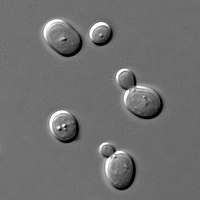
Photo from wikipedia
Abstract During ethanol fermentation, ethanol accumulates in the medium and becomes a significant stress factor for yeast. Trehalose and glycogen are major carbohydrate storages and presumably protect cells from such… Click to show full abstract
Abstract During ethanol fermentation, ethanol accumulates in the medium and becomes a significant stress factor for yeast. Trehalose and glycogen are major carbohydrate storages and presumably protect cells from such stress conditions. In this study, batch cultivations of wild and adapted Saccharomyces cerevisiae were performed to evaluate the fermentation kinetics and carbohydrate storages, interrelatedly. Trehalose and glycogen were determined by both High Performance Liquid Chromatography (HPLC) and Fourier Transform-Infrared (FT-IR) spectroscopy for comparison. The obtained maximum trehalose and glycogen (7.5 and 10.5 %) contents of the adapted strain was remarkably higher compared to the wild strain (5 and 6.5 %). The adapted S. cerevisiae displayed an enhanced fermentation stresses coping ability resulting in a higher ethanol productivity (2.03 vs 1.65 g ethanol/h) as well as higher ethanol titer (7.7 vs 6.4 %). This study contributes to the understanding of the cellular response of S. cerevisiae cells to fermentation stresses in relation to culture history together with the evaluation of fermentation performance, as well as the process kinetics. This study also confirms that FT-IR spectroscopy of whole S. cerevisiae cells for determination of storage compounds without pretreatment has valuable advantages compared to HPLC with intensive sample handling.
Journal Title: Process Biochemistry
Year Published: 2021
Link to full text (if available)
Share on Social Media: Sign Up to like & get
recommendations!